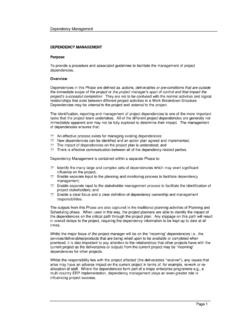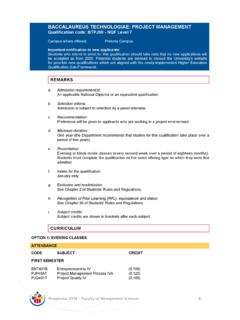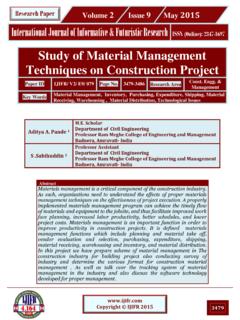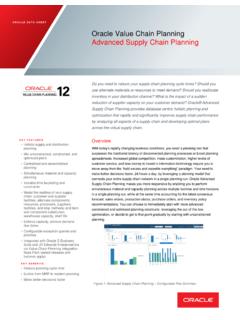Transcription of Treasury Management Systems Overview - EY - …
1 Treasury Management Systems Overview2013 Edition ContentsChapter 1: The challenges of Treasury Management ..1 Chapter 2: Differentiators for Treasury Management Systems ..2 Chapter 3: EY s Treasury system selection and implementation approach ..3 Chapter 4: Vendor profiles ..5 Chapter 5: Vendor responses ..8EY Treasury services contacts ..11 About the authors ..13 Treasury Management Systems Overview1 Chapter 1: The challenges of Treasury ManagementIntroductionVarious changes are occurring in the world of Treasury Management . Treasurers are confronted with the question of whether their information Systems can handle all of these new trends, which include: The growing need to collect financial information from a group s entities The expansion and increasing complexity of the kind of instruments handled The implementation of the Payment Services Directive The development of remote banking communication (elimination of the ETEBAC protocol, the growing strength of SWIFTNet, the appearance of EBICS [electronic banking internet standard] on the scene) The heightened expectations regarding the internal control of Treasury activitiesAt the same time, getting to grips with the range of software on offer that fulfills these needs is made more complex by rapid changes in technologies and approaches.
2 Software vendors aspire to cover an ever broader spectrum of Treasury Management needs stemming from market activities, the liquidity Management and banking this environment, the key factors for success in choosing a Treasury Management system are: Selecting a tool that is adapted to teams operational needs and that brings value to their operations Automating recurrent tasks, in particular reporting, in order to ensure permanence and relevance of the information Integrating reliable internal control solutions directly in the application s processing flowsWhat do Treasurers need to consider?Selecting a solution that is adapted to your needs Sifting and consolidating the responses via comparative analysis tables of functional and technical capabilities and overall costs, in order to facilitate the decision-making process and its acceptance by line personnelImplementation assistance Drawing up functional specifications and handling the relationship with the project ownership Monitoring the publishers work and providing project ownership assistance (budget and schedule monitoring, project reporting and governance, allotment and overall organization of the work) Assistance in gaining acceptance (setting up test cases, sequencing) Assistance in deploying the solution within the group Training users on the new toolsDiagnosing and improving automatic controls Identifying risk areas based on a standardized approach Defining a test program (sampling policy, test methods)
3 Recommending and implementing additional controls as needed2 Chapter 2: Differentiators for Treasury Management Systems The recent economic turmoil has refocused Treasury departments from crisis Management back to the task of efficiently managing activities and raises the question of what lessons can be learned and what opportunities can be leveraged from enhancing the organizations access to information through the improved Treasury Management Systems . How can the organization better employ technology to gain access to vital real-time information? For example, a finely implemented system will provide strong and automated functionality through automated payment solutions, real-time balance information, automated reconciliations and confirmations. It can also provide strong analytical tools to effectively measure and monitor financial risk positions in a volatile market and execute hedging of exposures to amiable pricing.
4 It may also offer the functionality to manage your liquidity positions through integrating cash forecasts (with careful input), balancing of foreign currency cash accounts, managing collateral, controlling banking authorities, monitoring credit, as well as enhancing the control , not all functionality is implemented in a smooth manner. In this version and previous edition of this Treasur y Management Systems Overview , we talked about the consolidation trend in the market for system vendors. The emphasis in the market seems to have shifted to replacing technology that Treasury has outgrown, was implemented with limited functional scope, replaced because of a forced retirement of the vendor s solution or as a result of recent Treasury integration. Although the fragmentation of the Treasury system market has been reduced, treasurers still struggle with the choice of selecting a system that offers the required visibility and speed of Management information while having the robustness for core Treasury functionality.
5 The key question for treasurers is twofold: What can I give up and what can I gain? and How do I differentiate among the Systems offered? With companies seeking a single, integrated, system solution for the bulk of their Treasury activities, how does a Treasury identify and evaluate the Systems available and translate this information into a comprehensive vision on which system or Systems might best meet their needs for the least amount of cost today and tomorrow? While technological developments within the Treasury landscape have been evolving, with a relatively stable state of providers, the focus has been in offering solutions tailored to the needs of Treasury departments. Although cost containment and improving profit margins is always top of mind, and is ever more so this year, we are observing a slight increase in initiatives to support technology improvements to achieve cost savings, particularly in industries where there is uncertainty regarding reform or regulation and those associated costs.
6 As such, a single- system solution that either is, or has the potential to be, fully integrated with the banking, trading or other portals ( , SWIFT) and ERP Systems , has become paramount to achieving these cost reductions. This wall-to-wall approach on system selection is continuing to be popular as companies try to save costs on interface support and system licenses for a more efficient and visible financial value chain in choosing a Treasury Management system (TMS)What are the main drivers in choosing a TMS? Is it the ability to effectively manage and monitor your trading risks in real time using a variety of complex instruments, or the ability to strengthen and improve cash Management , cash visibility and access, and cash flow forecasting tools and processes. Or is it the ability to interface with the ERP and generate automated payments? What should you consider in a TMS in order to make a sound choice between the most popular Systems on the market at the moment and the system that might best fit your needs?
7 We believe there are several key drivers in evaluating your choices: Identifying and prioritizing the needs for business-critical Treasury activities Identifying and evaluating solutions that can adapt to a changing business environment Identifying and evaluating costs and benefits associated with integration Assessing the software delivery model that best meets your functional and economic needs Assessing the system vendor and developing that relationship before, during and after implementation to best serve your needsTreasury Management Systems Overview3 Chapter 3: EY s Treasury system selection and implementation approachBackgroundWhen we work with clients to replace their current Treasury Management Systems , there is usually a fair amount of disenchantment with the client s present system or the realization that the system has served its useful life. The reasons for the disappointment vary, from realization that the system was not a good fit, or that it was a poor implementation of a good system , or that the system is incompatible or unstable in their environment.
8 However, the underlying theme appears to be a lack of clear expectations. To avoid this, companies should take a more pragmatic approach to system selection to help ensure the best system fit. In our experience, successful projects manage expectations by thoroughly assessing business requirements, focusing on project Management during selection and implementation, and considering the capabilities and capacity of the chosen vendor. EY Treasury Services has extensive experience in selecting and implementing Treasury Management packages. EY s approach is largely based on experience in assisting clients in selecting and implementing a variety of Treasury Systems , as well as our industry knowledge of Treasury Management . Based on EY s experience with the various vendors and an up-to-date understanding of the market and developments, EY can help shorten the system selection procedure and assist in its successful key element in the EY approach is a thorough and detailed understanding of your business processes and the definition of business requirements.
9 However, technological and data opportunities and restraints should never be ignored in the search for the system solution. Therefore, EY can also provide technical knowledge that is both conceptual and practical so that appropriate technological solutions are overall goal of EY is to support the client in selecting the most appropriate Treasury Management solution to meet its defined business requirements and to support clients during their implementation of their chosen solution. Implementation is seen as a separate phase from the selection process, as it depends to a large extent on the vendor and the package chosen. For the various Treasury Management packages, tailored implementation processes have been developed by EY, the vendors or other consultants. To avoid making any decisions in the selection phase that might negatively affect the implementation, EY firmly believes that any selection project should be approached as the preparation to start-up and planningBefore starting a project, a project plan should be drafted.
10 This plan should contain a description of the resources required, a clear timetable with deadlines and work-products and the responsibilities of each project member. Furthermore, it is important that the project Management is in place before the project gets under way. Phase 1: Strategic framework and requirements specificationThe first step EY takes in the selection process is to carry out an assessment to identify the client s strategic framework. The strategic framework provides the necessary setting for the Treasury Management system . Taking or confirming previous decisions on strategy, overall business processes, organization and system philosophy lays the foundation for the requirements specification. The importance of this phase is often forgotten or considered irrelevant to the system selection. If this phase is omitted, however, the project runs the risk of being based on the wrong assumptions, which could result in fundamental and costly revisions late in the selection or implementation phases.

















